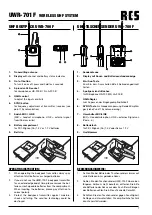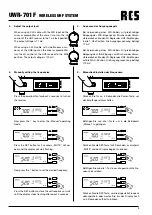
14
WIRELESS UHF SYSTEM
UWR-701 F
ALLGEMEINES ZU
UHF SENDE-UND EMPFANGSTECHNIK
INFORMATIONEN ÜBER RÜCKKOPPLUNG
Was ist eine Rückkopplung?
Eine Rückkopplung ist ein pfeifender, schellender und sehr
greller Ton, der sich selbst erregt. Befinden sich ein Mikro-
phon und ein Lautsprecher gleichzeitig in einem Raum, so
besteht die Gefahr einer Rückkopplung. Die Voraussetzung
für akustische Rückkopplung ist ein in sich geschlossener
Übertragungskreis.
Das Mikrophon nimmt ein Schallereignis auf, es wird ver-
stärkt und vom Lautsprecher abgestrahlt; die Schallwellen
des Lautsprechers treffen wieder auf das Mikrophon, werden
weiter verstärkt und wiederum dem Lautsprecher zugeführt
usw.
Wie vermeide ich Rückkopplung?
Positionieren Sie Ihr Mikrophon - wenn möglich - immer hin-
ter oder in ausreichendem Abstand zu den Lautsprechern!
ACHTUNG!
Ein durch Rückkopplung erzeugter Ton kann zu Gehör-
schäden und zur Zerstörung des Systems führen!
Um eine Rückkopplung zu vermeiden, sollten Sie die Laut-
stärke des Verstärkers vor jeder Inbetriebnahme auf Mini-
mum stellen. Nach Einschalten des Mikrophons bzw. der
Mikrophone erhöhen Sie die Lautstärke nun nach Bedarf.
SQUELCH-FUNKTION:
Von aussen einstreuende Störsignale (diese treten insbe-
sondere bei ausgeschalteten Mikrophonen auf) können mit
Hilfe des Squelch-Reglers unterdrückt oder ganz beseitigt
werden.
Drehen Sie in diesem Fall den Regler langsam im Uhrzei-
gersinn, bis die Störgeräusche verschwunden sind. Beach-
ten Sie jedoch, dass sich die Empfindlichkeit und somit die
Reichweite des Systems bei Verwendung der Squelch-Funk-
tion erheblich reduzieren kann.
GENERAL INFORMATION ABOUT UHF TRANSMISSION
AND RECEPTION TECHNOLOGY
INFORMATION ABOUT FEEDBACK
What is a feedback?
A feedback is a whistling, ringing and very bright tone that
excites itself. If a microphone and a loudspeaker are in one
room at the same time, there is a risk of feedback. The prere-
quisite for acoustic feedback is a self-contained transmissi-
on circuit.
The microphone records a sound event, it is amplified and
emitted by the loudspeaker; the sound waves of the lou-
dspeaker hit the microphone again, are amplified and in turn
fed to the loudspeaker, etc.
How do I avoid feedback?
If possible, always position your microphone behind or at a
sufficient distance from the speakers!
ATTENTION!
A sound generated by feedback can lead to hearing da-
mage and the destruction of the system!
To avoid feedback, you should set the volume of the amplifier
to minimum before each use. After switching on the micro-
phone or microphones, increase the volume as needed.
SQUELCH FUNCTION:
External interfering signals (these occur especially when the
microphone is switched off) can be suppressed or eliminated
with the help of the squelch control.
In this case, slowly turn the dial clockwise until the noise dis-
appears. Note, however, that the sensitivity and thus the ran-
ge of the system can be considerably reduced when using
the squelch function.


































